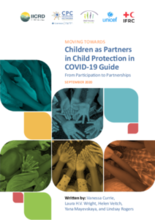At the outset of the COVID-19 pandemic, children and youth were facing unprecedented challenges caused by quarantine measures and school closure policies in nearly every country in the world. At the same time these challenges emerged, child-focused organizations found it harder than ever to communicate with children, needing to adapt their methods of hearing children’s voices and ensuring children’s participation to virtual and physically distanced realities. These adaptations are seemingly harder for adults and their organizations than for children, who are creative, innovative, and tech-savvy. Despite the COVID-19 challenges, children around the world have found meaningful ways to support and protect their peers, families, and communities. Children are on the frontlines of innovative responses and are working closely with their adult allies. The leadership demonstrated through these child-adult partnerships is the underlying inspiration for this guide.
Although the limitations of promoting children’s participation during COVID-19 are strong, child rights and child protection organizations that serve children should also have an obligation to engage with children. This engagement, which is likely to begin as consultation, will help organizations understand children’s realities and adapt their programs, services, and supports to their expressed needs. Clearly, with the new limitations that COVID-19 have created—including restrictions on group gatherings, adaptations or closures of school environments, and significant increases in the amount of time children spend in their households—should lead us to reflect seriously about the ethics of engaging with children in this time. How is it best for adult-led organizations to reach out to children? Who should do so, and how can they do so safely? This guide provides some guidance on those questions and links to additional resources.
But for all of the challenges, adults whose work is child-focused can and should promote children’s participation, even during COVID-19. Child participation is not only possible but is already happening; throughout this guide, you will read about numerous examples of child-led and child-centric initiatives that have emerged as the COVID-19 pandemic has spread around the world.
The beginning modules of this 5-module guide focus on quick tips and tools to start engaging with children immediately. The latter sections are designed to assist those who have found the quick tips and tools to be useful to engage in deeper reflection and action about how to practically center children’s voices and leadership in their work. This guide will be piloted in a handful of countries with the IFRC. If any country context or organization is interested in utilizing or adapting this guide, please reach out to the CP AoR Help Desks.
To accompany the guide, there is a shared Dropbox folder of resources, guides, and ideas for child participation during COVID-19 and an annotated bibliography of over 100 resources that are a sample of the larger folder.
View the modules and accompanying resources here.

